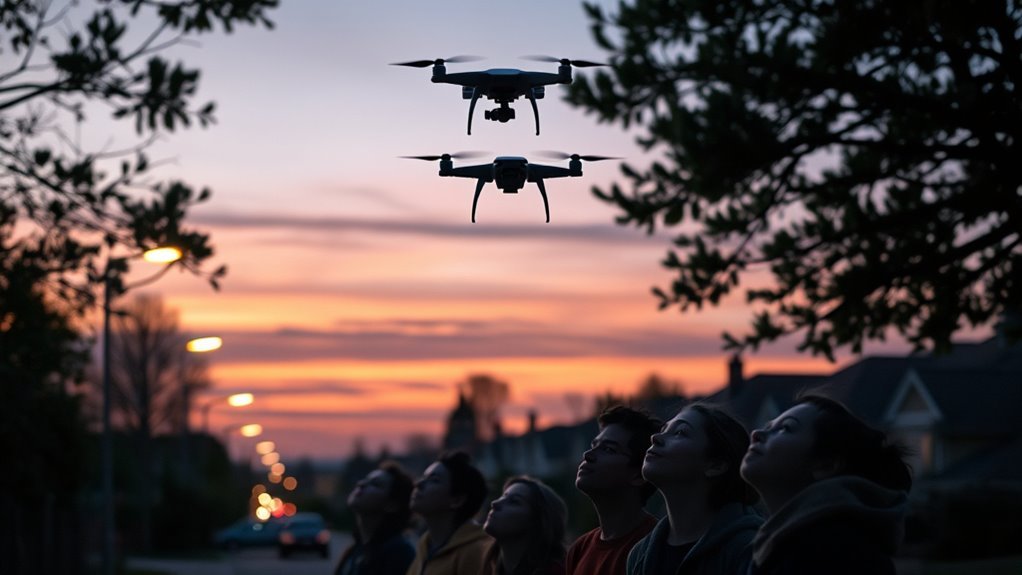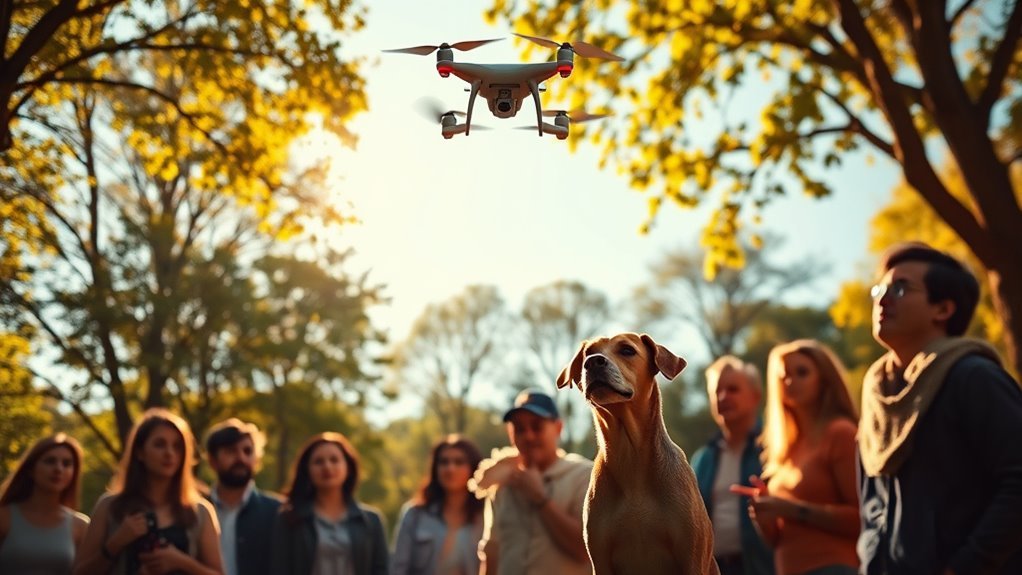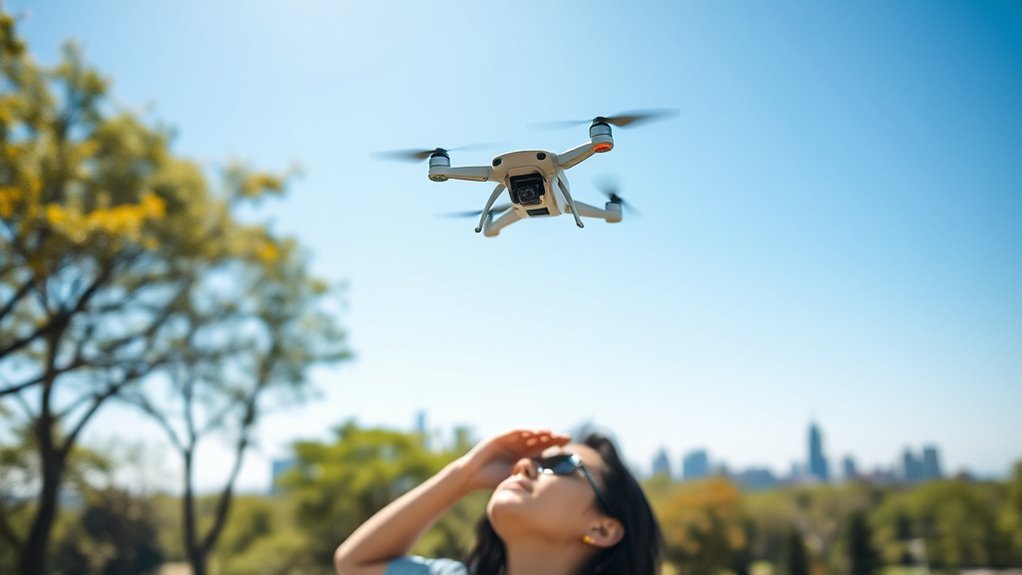To detect drones nearby, listen for unusual buzzing or whirring sounds, which indicate their presence. Visually, look for quadcopter designs and LED lights that change colors. Use smartphone apps like DroneWatcher or SkyDrones for real-time alerts. Monitor your Wi-Fi signals for sudden drops or unfamiliar networks that may signal drone activity. Pay attention to animal behavior; sudden changes can indicate nearby drones. Stay informed to enhance your detection skills and understand more tactics.
Listen for Unusual Sounds

Although you might not always notice them, listening for unusual sounds can be an effective way to detect drones in your vicinity. Drones typically operate at specific drone frequencies, producing distinctive sound patterns that differ from other aircraft or environmental noises. By training your ears to recognize these frequencies, you can identify the presence of a drone before it becomes visually apparent. Focus on the characteristics of the sound: a consistent buzzing or whirring indicates a drone, while irregular noises may signal other sources. Evaluating the volume and direction of these sounds can also help you gauge proximity. This auditory awareness empowers you to maintain your freedom, allowing you to respond effectively to drone activity in your surroundings.
Look for Visual Indicators

Visual indicators are essential for detecting drones, as they often exhibit specific characteristics that set them apart from other objects in the sky. By observing visual patterns, you can enhance your ability to identify these devices. Here are three key indicators to look for:
Visual indicators are crucial for drone detection, highlighting distinct characteristics that differentiate them from other aerial objects.
- Shape and Size: Drones typically have a distinctive quadcopter design, which is recognizable even from a distance.
- Movement Patterns: Unlike birds, drones often move in straight lines or sudden jerks, showcasing their mechanical nature.
- Lighting: Many drones feature LED lights that blink or change colors, which can help distinguish them from conventional aircraft.
Use a Smartphone App

Identifying drones can be greatly enhanced with the use of smartphone applications designed for aerial surveillance. These apps utilize advanced smartphone technology to detect drones in your vicinity, providing real-time alerts and data analysis. They often rely on GPS and sensor integration to pinpoint drone locations.
| App Name | Features | Compatibility |
|---|---|---|
| DroneWatcher | Live tracking, alerts | iOS, Android |
| AirMap | Flight zone information | iOS, Android |
| UAV Forecast | Weather data, drone alerts | iOS, Android |
| SkyDrones | No-fly zone mapping | iOS, Android |
| DroneRadar | Community reporting | iOS, Android |
Monitor Wi-Fi Signals
How can monitoring Wi-Fi signals help you detect drones in your area? By analyzing signal strength and potential Wi-Fi interference, you can identify unusual activity. Drones often emit signals that disrupt typical Wi-Fi patterns. Here’s how to effectively monitor:
- Check for Signal Fluctuations: Observe any sudden drops or spikes in your Wi-Fi signal strength; these could indicate drone presence nearby.
- Identify New Networks: Look for unfamiliar Wi-Fi networks that pop up suddenly, as drones may connect to local networks for data transmission.
- Monitor Bandwidth Usage: Keep an eye on unexpected increases in bandwidth usage, which can signify a drone streaming video or collecting data.
Observe Animal Behavior
Monitoring Wi-Fi signals can provide insights into drone activity, but another effective method involves observing changes in animal behavior. Animals often react sensitively to the presence of drones, which can disrupt their natural routines. You should pay close attention to unusual animal flight patterns; birds may suddenly alter their paths, while small mammals might freeze or flee. These wildlife reactions can serve as indicators of nearby drone activity. For instance, if you notice a flock of birds taking off abruptly or a group of deer scattering, it could signal an intruding drone. By carefully monitoring these behavioral changes, you can gain valuable information on potential drone presence, helping you maintain your personal space and freedom in the outdoors.
Frequently Asked Questions
Can Drones Fly at Night Without Any Lights?
Yes, drones can fly at night without lights, but it’s against night flying regulations in many areas. You should be aware of drone visibility concerns, as flying without lights poses safety risks to others.
What Is the Legal Height Limit for Drone Flights?
In the U.S., drone regulations typically limit flights to 400 feet above ground level. Understanding these flight restrictions is essential for maintaining safety and compliance, ensuring your freedom to operate drones without legal repercussions.
How Can I Report a Drone Sighting?
Isn’t it ironic how you’ve spotted a drone but don’t know how to report it? For effective drone reporting, follow your local sighting guidelines, providing details like location, time, and any identifying features.
Are There Specific Drone Types That Are Quieter?
Yes, some drone types are designed to be quieter models, utilizing advanced sound frequency technologies. These innovations minimize noise output, making them less detectable, which could enhance your experience if you value discretion in drone operations.
Do Drones Have to Be Registered With Authorities?
Yes, drones must be registered with authorities under drone registration laws. Failing to register can lead to serious consequences, including fines and restrictions, which can limit your freedom to operate drones responsibly and legally.

